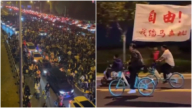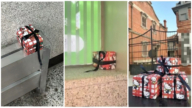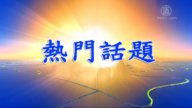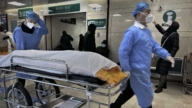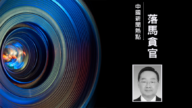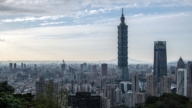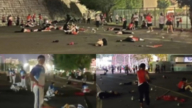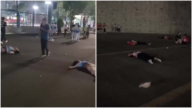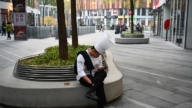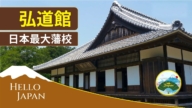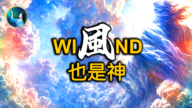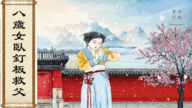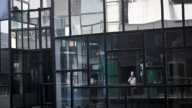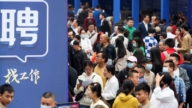【新唐人2011年4月27日讯】《纽约时报》签约摄影记者杜斌在香港再出版新书“毛主席的炼狱”。这本书收集了关于“大跃进时期”的13万文字和150多幅珍贵图画。杜斌表示,“毛主席的炼狱”再现了那个荒唐而又凄惨的年代。
这本图文并茂的书籍,收集了毛泽东的党内讲话、粮食官员的私人笔记、地方官员的言行、民间上书党中央的信件、最新披露的秘密档案、亲历者的追忆等文字,并以编年史的方式呈现出来。再配以“大跃进时期”的宣传画、农民画、艺术家绘画、报刊杂志插图、摄影照片等为政治服务的作品。从这些历史的碎片中来回眸那饿死数千万中国人的黑暗年代。
这些碎片和细节折射出那个时代的荒谬和独裁者的暴虐。张戎所着的“毛不为人知的故事”中写道,在一九五八年“大跃进”中,毛泽东为了让农民老老实实像奴隶一样干活,给这些人编上号,而不叫他们的名字。
杜斌:“我觉得像这样一个很小很小的细节,让我特别惊讶,也特别震撼,我觉得这就是毛泽东要把人的这种——名字是人的符号嘛——符号给抹杀了,把人变成工具,变成牲口一样来使用。”
书中记录的那段历史充斥着荒唐可笑,甚至在今天看来是黑色幽默。《炼狱》引用《人民画报》报导的内容,说:湖北省麻城县创造了亩产3.6万斤的高产“卫星”。但真相却是孩子们踩在藏着板凳的水稻上。
其中,刘伯威文章说,公社领导发动群众搞“人造太阳”和“人造风”来催生禾苗。只见试验田周围百来个群众人人手上捧着个大镜子,光芒四射直往田里照。
《炼狱》还引用罗平汉的文章:为了放卫星,试验田里不仅施加大量肥料,甚至给庄稼灌狗肉汤,注射葡萄糖。而李凯源文章说,一家手工业社大胆试验用中药炼钢,这些中药据称可以起到去氧脱硫、调解炭素的作用。
如果说“大跃进”的上半场是狂热和搞笑,下半场就是凄厉和哀嚎。当饥饿席卷中华大地,毛泽东灌输的共产主义理想瞬间坍塌,人们此时才看到大赤龙张开的血盆大口。
杜斌:“筛选这些故事的过程中,我是特别难过的。难过人的生命太卑贱了。在共产党的眼里太卑贱了。卑贱的跟一只狗、一只鸡、一只蚂蚁没有区别。有些细节透过我筛选出来的文字已经能展示出来,共产党政权根本就没有把人民的生命当回事。”
杜斌在《炼狱》中引用刘少奇家乡人写给他的一封信,内容说:“刘主席,我们天天在饿肚子,得了浮肿病还不能说,说了就要挨打饿饭,搞不好就说你是“反党、反三面红旗”,要送劳改。饿死人只能说是自己病死的。”
而杨继绳的《墓碑》一书也被杜斌引用了一段话,“当年信阳库里有粮10亿多斤,当年产量29多亿斤,共40亿斤。饥民看着粮库里有粮,也没有人想到抢粮食。有的农民坐在旁边等着政府开仓放粮,他们坐在粮库旁边喊:“共产党,毛主席,救救我们!”有人就饿死在粮库旁边。”
人吃人的惨剧遍及每个村庄。《炼狱》引述梁志远的文章说,“有时路上死人被人埋后,一夜就不见尸体了。有些地方,农民家里死了人,为了防止被人扒吃,就守坟多夜,待尸体腐烂发臭为止。有的吃人家的死人,有的吃自家的死人﹔人肉有吃熟的,也有吃生的﹔有吃死尸的,也有杀吃活人的。”
杜斌表示,《炼狱》这本书的出版正好赶上中共建党九十周年。现在北京的书店里关于中共党史的书一本接一本的在出版,还有一本书专门写给中学生看的。中共试图美化他的历史,遇到“文革”和“大跃进”的内容就轻描淡写带过,竭力把它不光彩的那一面从他的历史里面剔除。而《炼狱》这本书可以说是把残缺的历史补齐,把真实的伤痛呈现。
新唐人记者秦雪、王明宇采访报导。
======
“Chairman Mao’s Purgatory” – The Reality
Du Bin, a New York Times’ signed reporter,
published in Hong Kong a new book, called
“Chairman Mao’s Purgatory”. .
This book is about the Great Leap Forward
and has 130,000 characters
and over 150 valuable pictures.
Du Bin said: “’Chairman Mao’s purgatory’ reflects
all those ridiculous and miserable years.”
This book in the form of chronicle, records Mao’s
speech within the party, agricultural officials’
private diaries, the behavior of local authorities,
letters from common people to the Central Party,
newly revealed secret documents, witnesses’
memories. The book recalls the dark age when
tens of millions of Chinese people starved to death,
with historical posters, farmer paintings, photos,
art drawings, newspaper and magazines’ pictures,
serving the politics during the Great Leap Forward.
These fragments and details reflect those ridiculous
years and the dictator’s outrage. According to
Zhang Rong’s book “Mao: The Unknown Story”,
to make peasants work as slaves during 1950s’
Great Leap Forward, Mao Zedong assigned
numbers to them instead of calling their names.
Du Bin said: “I find such a small detail surprising
and shocking. Mao erased people’s names
which were their identities and
utilized them as tools and animals.”
We can find in the book those ridiculous years
and black humor when we look back. “Purgatory”
cites China Pictorial’s reports: “Macheng County
in Hubei Province created a ‘satellite’ of producing
36,000 jin (18,000 kg) of grain per mu.”
But actually children were standing on paddy rice
propped with hidden benches.
According to Liu Bowei’s article, officials of people’s
commune organized activities like “man-made sun”
and “man-made wind” among people to hasten the
growth of rice. Hundreds of people were standing
around experimental fields with mirrors in hands,
making the sunshine reflect into the field.
“Purgatory” cites Luo Pinghan’s article: “To launch
satellites, people applied fertilizers excessively and
watered the rice with dog meat soup and glucose.”
Also according to Li Kai’s article, a handicraft
commune even made steel with Chinese medicine,
which was believed to remove oxygen, sulfur
and to control carbon content.
The first half of the Great Leap Forward was just
craziness and humor, but the second half was
a tragedy. When hunger swept the whole country,
the communist ideal implanted by Mao collapsed
and at that moment people saw the red dragon
opening its bloody mouth.
Du Bin: “I was sad when choosing the stories,
because people were so humble in the eyes
of communist party, as humble as a dog, hen, ant.
Some details I selected can truly reflect the fact
that the communist regime doesn’t care
about people’s lives at all. ”
In “Purgatory”, Du Bin cited a letter to Liu Shaoqi
from his fellow villagers which said: “President Liu,
we are starving everyday and developing edemas.
But we couldn’t talk about it, otherwise we’ll have
no food, be labeled as “anti-party and
against the three red banners” and be sent to
forced labor camp. Once a person starves to death,
people could only say that he dies of disease.”
Du Bin also cited a paragraph from Yang Jisheng’s
book, “Tombstone", “There was over 1 billion jin of
grain in Xinyang City’s warehouse and the total
storage is 4 billion jin, with 2.9 billion jin production
that year. But not even one famine victim
considered to steal food, knowing there’s plenty
in the warehouse. Some peasants waited
outside the warehouse for the government
to distribute food and shouted:
‘Communist party, Chairman Mao, help us!’
Some people died at the warehouse.”
The tragedy of people eating each other swept
every village. “Purgatory” cites Liang Zhiyuan’s
article, “Sometimes a dead person was buried
but the body disappeared overnight. In some areas,
to protect dead bodies from being dug and eaten,
peasants watched their family members’ graves
for several nights until the bodies started
to decompose and putrefy. Some people ate
dead bodies from other families and some ate
dead bodies from their own families; people ate
cooked or raw human flesh; some ate
dead bodies and some killed and ate live people.”
Chinese Communist Party) 90th anniversary.
Other books about CCP’s history are coming out
one by one in Beijing’s bookstores and there is
even one for middle school students.
In these books, CCP tries to glorify its past and
writes lightly about the Cultural Revolution and
the Great Leap Forward, trying to remove
its dark side from history. But “Purgatory” fills
the blank of history and presents the real pains.
NTD reporters Qin Xue and Wang Mingyu


